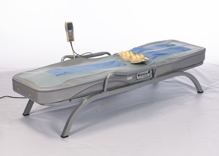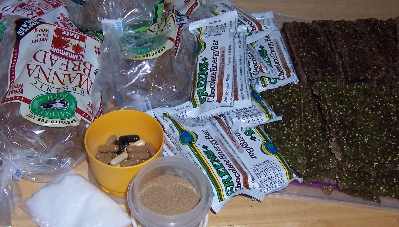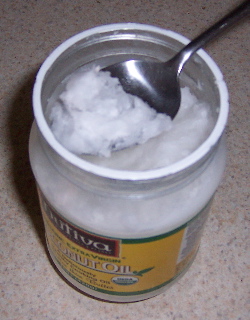Fighting food cravings
Sunday, March 9th, 2008I often hear people say that food cravings are an indication that your body needs nutrients that are in the food you are craving. For the vast majority of people, this is a complete fallacy. Through years of junk food abuse, our bodies have become addicted to foods that make us feel terrible. This is no different from cravings for cigarettes, alcohol, or drugs. We can become addicted to meat, sugar, wheat, dairy, salt, etc.
I’m a “food-motivated” individual, so I sympathize with people suffering from uncontrollable food cravings. I haven’t completely eliminated mine, but I’m getting pretty close, so I thought I’d share a few strategies that I have used to combat them. I’ll admit up front that I have no way of knowing whether these strategies were actually effective or if it was just a coincidence.
- Probiotics: Our digestive tracts should be teaming with healthy bacteria that helps us digest food and produce nutrients. Due to overuse of antibiotics (in people and in food animals) many of us no longer have nearly enough healthy bacteria. Making things worse, a lack of healthy bacteria allows unhealthy bacteria to colonize. The theory goes that these unhealthy bacteria actually crave the sugar and processed carbohydrates so that they can continue to thrive. Get rid of the bad bacteria and replace it with good bacteria, and the cravings subside. I took these high quality probiotics every day for about 3 months. I can’t prove it was the probiotics, but unhealthy comfort foods stopped appealing to me during that time, and my diet became much cleaner with no real mental effort on my part.
- Colonic irrigation: Ew gross, I know. Believe me, I don’t really want to talk about it. But these do wonders. I was having near constant pasta cravings for months and ever since I got a colonic in January, that craving has not returned. They are supposed to be great for a whole host of other health issues too, and several of the health gurus swear by them.
- Endive: According to Victoria Boutenko’s book, Green for Life, a leafy green known as endive contains the amino acids tyrosine and phenylalanine, which help fight food cravings. I have no personal experience with this, but I thought I’d mention it.
- Time: It may be a cliche, but the passage of time really helps. When I gave up meat, I craved bacon for at least 3 years. Eventually it did pass. A couple of times I ate non-vegan foods by accident and they actually tasted quite foul because my tastes adjusted naturally along with my diet.
The easing of the food cravings hasn’t been all good though. My biggest problem these days is that I still get strong urges to indulge in “forbidden foods” but none of the old comfort foods look good to me anymore and they never taste nearly as good as I remember them. My body seems to thrive on fresh whole foods. My mind has a lot of catching up to do. This can make for some very frustrating trips to the grocery store.
![[del.icio.us]](https://www.vegangirl.com/wp-content/plugins/bookmarkify/delicious.png)
![[Digg]](https://www.vegangirl.com/wp-content/plugins/bookmarkify/digg.png)
![[Facebook]](https://www.vegangirl.com/wp-content/plugins/bookmarkify/facebook.png)
![[Google]](https://www.vegangirl.com/wp-content/plugins/bookmarkify/google.png)
![[Ma.gnolia]](https://www.vegangirl.com/wp-content/plugins/bookmarkify/magnolia.png)
![[MySpace]](https://www.vegangirl.com/wp-content/plugins/bookmarkify/myspace.png)
![[Reddit]](https://www.vegangirl.com/wp-content/plugins/bookmarkify/reddit.png)
![[StumbleUpon]](https://www.vegangirl.com/wp-content/plugins/bookmarkify/stumbleupon.png)
![[Technorati]](https://www.vegangirl.com/wp-content/plugins/bookmarkify/technorati.png)
![[Twitter]](https://www.vegangirl.com/wp-content/plugins/bookmarkify/twitter.png)
![[Yahoo!]](https://www.vegangirl.com/wp-content/plugins/bookmarkify/yahoo.png)
![[Email]](https://www.vegangirl.com/wp-content/plugins/bookmarkify/email.png)
 There is a horrifying trend in the U.S. to put everyone on pharmaceuticals for mood disorders, rather than trying to find and correct the underlying cause. The medical industry wants us to buy into this idea that we are helpless victims of circumstance, rather than in control of our physical and mental health. They dismiss diet, exercise, and environmental factors as possible minor contributors, but even that seems to be too “inconclusive” for them.
There is a horrifying trend in the U.S. to put everyone on pharmaceuticals for mood disorders, rather than trying to find and correct the underlying cause. The medical industry wants us to buy into this idea that we are helpless victims of circumstance, rather than in control of our physical and mental health. They dismiss diet, exercise, and environmental factors as possible minor contributors, but even that seems to be too “inconclusive” for them. I love a good massage. Ever since I got into the high tech industry, I’ve had a couple of knots in my back that ache and throb after working all day. For a while I had health insurance that covered weekly massages and my company had an amazing massage therapist who visited the office regularly. She was so good that I would be dizzy after every session. My back wouldn’t ache at all for days.
I love a good massage. Ever since I got into the high tech industry, I’ve had a couple of knots in my back that ache and throb after working all day. For a while I had health insurance that covered weekly massages and my company had an amazing massage therapist who visited the office regularly. She was so good that I would be dizzy after every session. My back wouldn’t ache at all for days.

